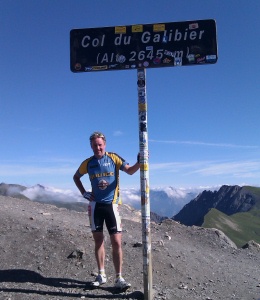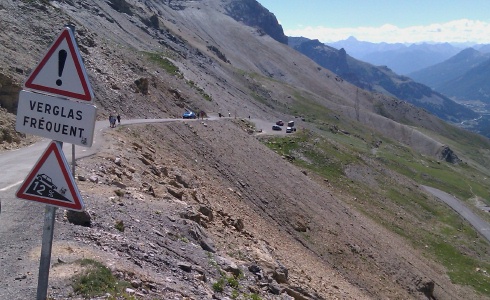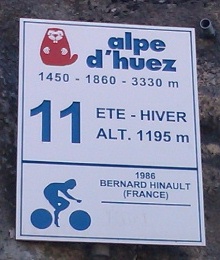|
“A
mountain is not an obstacle, it is an opportunity”. R.Millar.
The UK has an ambivalent relationship with the bicycle. Our motorsport
heritage is what appears to set the tone for road usage and attitudes.
Bikes are second class citizens and basically a nuisance. The continental
view is different. In France for example, mount a velociped, Route
or VTT, and the difference is immediate and tangible. Of course France
plays host for three weeks every year to its own backyard bike race
called the Tour de France. Broken only by global conflict, the TdF
has been bringing its road system to a halt since 1903. It is what
sets the tone for how the bike is regarded over there. On a bike you
rise to a higher level. Once you realise that cycling in France is
an activity worthy of serous intellectual analysis, it all becomes
clear. The bike is a test of courage, moral and character, like the
relict bull-rings of the south, a forum for epic individual combat.
On the bike you are elevated to one of the ‘special ones’ and
for this you receive space, time and honour. France has been denied
success in its home Tour since 1985. Cycling, however, still has a
special place in the hearts of the French. You can see the enthusiasm
everywhere from toddlers that can barely walk let alone reach the pedals
to veterans with skin and muscle as tanned and leathery as that chap
they dragged out of an Essex bog somewhere near Hainault.
|
|
Talking
of which; L’Alpe d’Huez. From the foot of the climb
at Bourg D’Oisians, 21 hairpins, each numbered and named
after a former stage winner there. Bernard Hinault (pronounced
like
the keyboard player from Roxy Music) is virage 11. He won
his stage in 1986 only to be second overall that year behind
Mr
LeMond. The first time an American stole ‘their’ Tour
and the first of his three brilliant wins. I did not concentrate
too much on the names on the way up. You know they are there
though; Hererra, Hampsten, Zoetemelk, Pantani, Armstrong
(Curiously Merckx never won here). They look over your shoulder
as you
concentrate on a rhythm winding up through the trees to la
Garde d’Huez past the Church and war memorial. Beyond
the small village of Huez the tree’s recede, the road opens
up and the ski-station comes into view, new, brash and ugly. You
know now that you are well past the half way point. You can afford
a little guilty acceleration at this point. Perhaps it is the photographer
pointing his lens at you or perhaps it is knowing that you have only
started from the bottom of this mountain and not 100km away in another
valley on the other side of some other mountain. |
‘The’ alpe is
a dead-end to nowhere. It is usual to finish here in a mountain-top
sprint. A normal etape is nearly over by the time the riders start
on virage 21. The record for the climb is 36 minutes 50 seconds.
Marco Pantani in 1995. That day the stage covered 163ks, climbing
the Madeleine
and the Col de Croix de Fer as Hors d'oeuvre before devouring the
Alpe as main course. He was reported braking into each hairpin. My
time?
Irrelevant really. 1hr 15 minutes if you want to know. It’s
not the most picturesque of mountain climbs, it is not the hardest
or longest,
but it is perhaps the one with the most history distilled into that
little ribbon of asphalt. It has become an icon of the Tour. It is
a must do….
Total distance |
14.0K |
Average gradient |
8.0% |
Summit height |
1850M |
Steepest gradient |
14.0% |
Total high gain |
1090M |
Average rise between hairpins |
50M |
I have a calendar on my wall and I was looking forward to July.
July is a picture of Robert Millar leading Greg LeMond, Laurent
Fignon and
Gert Jan Theunisse on a hot, high, dusty mountain pass in the 1989
Tour. If you don’t know who Robert Millar is, shame on you. The
Tour was the one that Fignon lost by 8 seconds to LeMond. The high
pass was the Col d’Izoard. I cycled the Izoard with thoughts
of Millar. An enigmatic Scot, he won the KoM in 1984. I was living
in Glasgow at the time, just round the corner from Billy Bilslands
bike shop in Goven. Billy Bilsland, former international cyclist with
the Peugeot squad, was a sort of mentor to Millar in his early days.
I have a yellow Billy Bilsland musette that I used as a sandwich bag
on my trips around Loch Lomond on my Dads steel Mercian (44/41 Campag).
The picture shows Millar in the iconic ‘Z’ team jersey
at a spot next to the memorial stone to Fausto Coppi and Louison Bobet.
I stopped on the way down to get a picture here. It is a cauldron,
a bare, volcanic shadeless place. I rode at a leisurely pace, I cannot
imagine how it must be at racing speed. My Millar pilgrimage started
from Guillestre, a lovely market town in the Durance valley. The road
leaves the Durance and climbs east through tunnels and into the magnificent
Combe du Queryas. Never excessive in gradient, but a constant ‘fasle
flat’ of 2-3% warms the legs for 10k or more. Just before you
reach the ancient Chateau Queryas the road suddenly veers left requiring
an immediate response. A change from 25 to 27 at the back and a launch
on the pedals. From here the straight 7k to Brunissard is a 4% soul-destroying
grind. Senses tell you the road should be flat but you are smothered
by an invisible force. The air converts to water, tyres are Velcro
on the tar. Moving very slowly past static telesiege and through buzzing
alpine meadows this was the crux and negative thoughts made this a
dark section. Reaching the zig-zags above Brunissard a type of relief
is achieved, drop it into trente neuf-vingt huit and the hairpins free
you to dance on the pedals. It may be steeper but here you can see
gravity your enemy and fight against it. You reach that spot, 3k from
the summit where the photograph of Millar was taken. It’s called
the Casse Desérte. A special geological area of screes and
rock pinnacles where the minerals have stained the decaying
limestone into kaleidoscopic colours. This place is spectacular.
In the photograph I have, Millar is taught, LeMond relaxed, time
has rendered
it glamorous. Robert Millar escaped from that dour early eighties
Glasgow I knew and here he was, wearing the jewelled cape of a ‘Z’ matador
in an epic struggle with the greatest cyclists in the world. Fignon
was dropped that day by 30 seconds by LeMond on the finish into Briançon
and many consider this is where he lost the closest Tour in history,
not in Paris. Millar finished in 10th place overall that year. Half
a minute meant nothing to me. I measured my ascent in hours. There
is a difference, not just in the quarter century between the picture
on my wall and the digital image I now have, but in the gulf in ability
and courage required to cross these places at racing speed.
Total distance
|
33.0K
|
Average gradient |
4.5% |
Summit height
|
2360M
|
Steepest gradient |
7.0% |
Total high gain
|
1428M
|
|
|
The Galibier has two faces.
The south face rises gently from the subsidiary summit of the Col
de Lautaret at the top of the Romanche
Valley, itself
at 2058M, in a series of wide green sweeping bends to its summit
at 2646M. The north face is another beast. From the mean huddle
of chalets
at Plan Lachat it does not seem possible that a metalled road can
climb out of the cirque of mountains into which it has led. This
is the Galibiers
mean face, longer and steeper than its twin and the way the Tour
normally transfers its victims from the Maurienne to the Romanch
valleys. The
Col du Galibier is the quintessential Tour climb. It symbolises
all that is challenging and character-building of the Tour. It
is not
an obstacle but an opportunity to explore the heart of the compulsion
that is cycling over mountains.
Starting from the top of the Lautaret is a cheat. I pushed hard
to expunge this guilt. I reached the summit surprisingly easy,
only
needing 39/23. Forty minutes for 580M gain, not bad. But I was
not happy, this
was not the Galibier I was expecting. The Galibier could and should
bite. A scorching day in the valley, it was a pleasant spring day
up here at the col. Think back to 1998, check the YouTube footage
if you
want, Pantani on the Galibier, again with a trademark ferocious
attack but this time in atrocious weather, so cold the organisers
feared
the riders would freeze on the descent preventing the use of their
brakes.
Pantani had enough of a lead at the summit to stop and don his
wind jacket. Jan Ulrich, 5 minutes behind at the same point eschewed
any
clothing, he froze and lost over 8 minutes on the final climb of
the day to Les Deux Alpes. 1998 was the year of ‘Il Pirata’.
In 1935 a Spanish rider was pitched off one of the hairpins descending
toward Briançon and died three days later in hospital in Grenoble,
the first of the Tours’ three fatalities. I had not suffered
enough yet to get to the core of this mountain.
I descended northward, each hairpin took me down towards Valloire
and I realised I was dropping into an unknown, this was a long
way and
boy was it a long way back. My nerve finally gave out at Plan Lachat,
half way down the valley. I stopped and scanned the road I had
just travelled. The only evidence from below were the shiny tops
of cars
and campers, glinting ball bearings crossing each other like some
enormous pinball machine being played out on the side of the slope.
I had a
second guilt-pang. Am I doing this mountain justice? Have I stacked
the odds in my favour? The task ahead partially dispelled these
thoughts, even here on this meandering section I was in my lowest
gear, an
abrupt swing to the right and the first of the steep ramps, no
more gears,
only out of the saddle left. More remarkably steep ramps, each
hairpin springing back on itself with vehicles and other riders
directly
above my head or below my feet as I was snapped back and forth
like that
shiny pinball side to side across the mountainside. This was what
I was here for. I was now suffering, but from this struggle emerged
a sense
of something that was beautiful and blissful. I was doing this
and it was hurting, but it was right and whatever it was, it was
beautiful.
This sense of calm and blissfulness (Ãnanda?) connected
me back to steep Pembrokeshire limestone and gnarled Scottish Gabro
where the
micro-beauty of feldspar and hornblende grains under your finger
tips and the utter concentration required to stay alive, intensify
the experience
into something spiritual. On this hill, concentrated stress, sensory
inputs, pleasurable and nociceptive, distilled together into a
moment of beauty. The Galibier is a beautiful mountain. Like time
spent in
vertical space, the alchemies of physical and mental attrition
draw me back wanting more of this spiritual high.
This mountain did not have its chance to best me. The true start
point should lie in the Maurienne valley where the preliminaries
of the Col
de Telegraph and the approach through Valloire make it a test to
savour. To quote the famous climber Don Whillans, ‘The mountain
will always be there son, just make sure you are’.
Total distance
|
17.0K
|
Average gradient |
7.0% |
Summit height
|
2645M
|
Steepest gradient |
10.0% |
Total high gain
|
1245M
|
|
|
S.W.N. Thompson. Aug. 2010.
|


